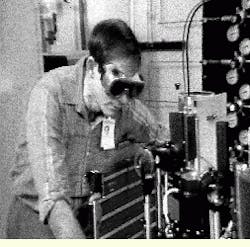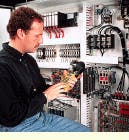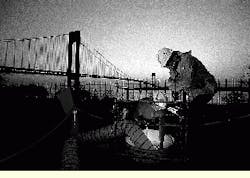Installing optical fiber safely
Safely installing optical fiber calls for special care in working with lasers, ultraviolet light and chemicals, as well as the general safety precautions applicable to any installation.
Larry Johnson
The Light Brigade Inc.
Optical fibers, most of which are made of glass, pose many hazards for the unwary. Fiber fragments or splinters can easily penetrate fingers, toes or eyes and can be difficult to remove. A pair of Teflon-coated tweezers makes it easier to remove fiber fragments from the skin. The best way to prevent eye damage is by wearing protective eyewear. Clear plastic lenses prevent minute fiber fragments from entering the eyes.
When working with optical fibers, choose your work surface carefully. A chemical-resistant, non-reflective surface is ideal for laboratories, while a black mat serves well as a temporary work surface. A dark working surface provides contrast for the clear fiber, permitting safe handling and disposal.
Eating and drinking around fibers is dangerous because bits of fiber can fall into drinks or stick to food. Because minute glass fragments can stick to skin oils, thoroughly wash your hands after working with fibers and before touching your face or eyes.
In work areas, smooth floors such as tile or concrete surfaces are preferable to carpets because they can be swept clean after optical work is performed. Computer rooms with raised floors covering cable runs are usually pressurized, with the underfloor areas acting as air ducts. When a tile is removed for cable access, a sudden gust of pressurized air can blow fiber chips into the eyes. For this reason, it is imperative that safety glasses be worn in this environment and that fiber debris not be dropped into openings in raised floors.
Installers not only have the responsibility for their own safety but also for the safety of others who may come in contact with fibers or fiber waste, which should never be put in ordinary waste bins for routine disposal. To make more room in a wastebasket, an unsuspecting worker may try to compress the garbage, only to receive a nasty surprise; or someone may reach into a wastebasket to remove something, not seeing the sharp fibers. It is best that garbage containing fiber waste be sealed and disposed of by the fiber craftsperson.
Laser safety
Lasers used to transmit signals over optical fibers pose another potential hazard. An advantage of fiber systems is their ability to transmit over long distances using solid-state laser diodes, but these high-powered devices can be a potential eye hazard at points distant from the laser when used with low-loss optical fibers.
Lasers used as signal sources for optical fibers operate at wavelengths of 850, 1300 and 1550 nanometers, all of which are in the infrared part of the spectrum. When viewed by the unprotected human eye, light at the first two of these wavelengths, along with light at the visible wavelengths, focuses on the retina. Retinal receptors are sensitive to wavelengths between 400 and 700 nm, but not to wavelengths outside this range. The danger is that, although you cannot perceive the intense light from a laser, that light is still being focused on sensitive retinal tissue. At the focal point of the beam, energy density can be high enough to burn this tissue, resulting in loss of visual acuity or blind spots in the visual field. This is true even though fiber-optic lasers operate at lower power than other types of lasers. Because of such safety concerns, the government regulates laser use. The regulations classify lasers into four general categories according to their accessible radiation during normal use and maintenance. The class of an individual laser depends on its operating wavelength, its output power and whether it is pulsed or continuous-wave.
Of most interest to campus and premises cabling installers will be infrared lasers as they are addressed in the Z136.2-1988 standard of the American National Standards Institute (New York, NY). These Class I lasers are considered eye-safe because no eye damage will result even from prolonged exposure to the direct beam. Light at shorter wavelengths, especially wavelengths below 550 nm, is more readily absorbed by the retina. It is this absorption that damages the eye, so eye-safe output power can vary with wavelength. The maximum output power of Class I lasers generally increases with increasing wavelength. Laser emissions at wavelengths greater than 1400 nm are absorbed by the cornea and do not penetrate to the retina, so the maximum output power of Class I lasers increases dramatically above this threshold.
There are literally hundreds of laser types used in applications from communications to welding. While the ANSI standard spells out safe use of lasers in fiber systems, it is important that you determine the characteristics of all laser sources that you use so you can handle them safely.
All lasers used with fiber communications systems operate below the energy level that causes skin burns, but they pose a real danger to the eyes. This danger is highest at optical output ports, where energy is coming directly from the laser, particularly at active housings containing laser chips in the connector ports.
Never look directly into any optical port. Unused ports should be capped to prevent accidental exposure to laser emission, and equipment should never be mounted at eye level. Before using an inspection microscope to visually inspect a connector, use a power meter to confirm that the fiber is not transmitting optical energy.
Keep in mind that wavelengths of 850 and 1300 nm focus on the retina, while the 1550-nm wavelength does not. Therefore, fiber-optic systems operating at 850 and 1300 nm pose a much greater hazard than those operating at 1550 nm.
Equipment containing lasers must be properly labeled at the ports where optical energy is emitted. The label must state the type of laser and its class, as well as precautions you should take and a brief warning message about the type of danger the laser presents. Since patch-panel manufacturers do not know what types of light sources will be crossconnected at panel locations, their safety labels may not supply the proper information to meet adequate safety guidelines. Safety labels that deal with actual performance specifications may be purchased through many suppliers.
When working with lasers that exceed safe exposure limits as outlined in the ANSI standard, wear protective lenses designed to attenuate laser energy at key wavelengths. Laser safety glasses are available for every type of laser in use today. Broad-spectrum glasses can be used with a number of laser wavelengths, but glasses that are designed for a specific wavelength usually offer better protection than the broad-spectrum models.
Fiber technicians may also encounter an optical hazard completely unrelated to lasers. The ultraviolet curing lamps used with some types of splices or connectors can be dangerous. They produce both long-wavelength UV light, at wavelengths between 320 and 400 nm, and short-wavelength radiation, at wavelengths shorter than 320 nm. The shorter the wavelength, the more dangerous the radiation. Short-wavelength UV radiation can induce chemical changes in living tissue that can cause malignant melanoma in skin and damage the cornea.
Many UV curing lamps have internal filters to eliminate the shorter-wavelength energy, and exposure to longer-wavelength UV radiation is safe, provided the person does not stare into the light for prolonged periods. When using these devices, even ones containing filters, never look at the light, because UV radiation-induced damage to eyes and skin is cumulative.
Chemical safety
When you are working with solvents, there is always the danger of fire. Solvent vapor can build up in poorly ventilated areas where a cigarette or the discharge from a fusion splicer could cause an explosion.
Smoking is never recommended when working with fiber, not only because of the risk of fire or explosion but also because of potential contamination problems. The small size of optical fibers means that contaminants like smoke particles can ruin or degrade an otherwise perfectly made connection or splice.
Solvent bottles should not be left uncapped, since they can easily be knocked over. In addition, solvents exposed to air will quickly absorb atmospheric moisture, as well as other contaminants, making them less effective as cleaning agents.
Rather than keeping bottles of solvents for fiber cleaning, use disposable items such as alcopads and optic pads. They are inexpensive and easy to use, and they reduce the risk of a solvent fire.
Many types of adhesives are available for use with optical fiber. Some epoxy-based adhesives require mixing before use and can be strong irritants to skin and eyes. When using chemicals or epoxies, work in a well-ventilated area.
UV curing adhesive has a low viscosity and is often supplied in syringes. If the syringe tip clogs and more pressure is applied, the adhesive may suddenly squirt out and get in your eyes or the eyes of a bystander. Prevent this type of accident by using safety glasses.
Other chemicals commonly encountered in fiber-optic installation are index-matching fluids, cable-pulling lubricants and cable moisture repellents. Any of these chemicals may cause irritation or possibly allergic reactions in some people. Proper clothing, including gloves and eyewear, may be needed to keep the workplace safe. Also, you should develop good cleaning habits after working with chemicals, especially before eating.
Installation safety
Safety issues are also important when installing fiber cable. Manholes and underground cable vaults can collect poisonous hydrogen-sulfide gas from nearby sewer systems, as well as other heavier-than-air, poisonous or flammable gases. Such gases can overcome and kill a person within seconds, so this hazard is not to be taken lightly. A gas analyzer should be used before entering a manhole or vault to ensure that a hazardous gas is not present. Ventilating equipment can also be used when you are working underground; in some cases, such equipment is required.
When pulling cable with power-driven winches, take care that clothing does not become entangled in the machinery. Never stand opposite pulling lines, cables or hardware under tension. If a sudden break occurs, the whiplash effect could cause serious injury or even death.
Lubricants are sometimes used to decrease friction during cable installation. Lubricants have low viscosity and are extremely slippery. In case of spills, an absorbent material like sand or sawdust can be used to temporarily prevent accidents until the spill can be properly cleaned up.
Aerial installations come with their own set of dangers. Many fiber cables are installed on existing power utility rights-of-way. Although proximity to high-voltage lines does not affect the fibers, it does pose hazards for human installers. High voltages can arc across air spaces to an alternate path to the ground, which can include ladders, lift equipment and human flesh. If you become such an alternate path to the ground by touching or coming too close to a power line, you could be severely burned or killed.
Occupational health and safety codes provide distance limits governing your approach to aerial power lines. These distances depend on the level of voltage in the lines but range from 3 to 5 meters.
Even when an aerial cable does not carry high-voltage lines, shock danger may still exist. Long lengths of cable can build up lethal amounts of static electricity that will discharge through a person attempting to work on it. To prevent this, use grounding clamps to connect the cable exterior to a good solid ground at each utility-pole site. Metallic messengers must also be grounded in this way. This procedure will also protect the cable from possible lightning damage.
In addition to avoiding electric shock hazards, those working on aerial installations must be careful about falls and dropping heavy articles on people standing below them. Hard hats, heavy protective clothing and thick gloves are musts in these work environments.
When working at night, wear reflective colors and use appropriate signs to meet or exceed local, regional or federal safety requirements.
Editor`s Note: The safety issues and protective measures discussed here do not constitute an exclusive list of all safety issues and potential protective measures relevant to fiber optics. Numerous potential safety hazards and protective measures exist that are not mentioned here, being beyond the scope of this article. Failure to include any such item here is not meant as a comment on the potential danger of any such safety hazard or the potential utility of any safety measure or technique. Although the safety measures suggested here are intended to reduce the general risk of accident and injury, they will not be adequate or effective in all situations. You should consult a safety expert or other specialist as may be appropriate. The safety measures and other information in this article are subject to and do not supersede any applicable company, local, state or federal rules and regulations.
Safety glasses are important for protecting the eyes when working around lasers.
Fiber-optic cables can be labeled so that anyone working on them will be aware of danger from laser emissions. A number of manufacturers make warning tags for marking the cables, or markers can be custom-made, as this technician is doing.
Working outdoors at night calls for special safety precautions--reflective clothing as well as warning lights, protective barriers and proper signs.
Larry Johnson is president of The Light Brigade Inc., Kent, WA. This article is excerpted from The Light Brigade`s training video, Fiber Optic Safety.



